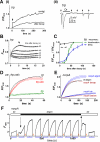Arrestin translocation is stoichiometric to rhodopsin isomerization and accelerated by phototransduction in Drosophila photoreceptors
- PMID: 20869596
- PMCID: PMC2946946
- DOI: 10.1016/j.neuron.2010.08.024
Arrestin translocation is stoichiometric to rhodopsin isomerization and accelerated by phototransduction in Drosophila photoreceptors
Abstract
Upon illumination, visual arrestin translocates from photoreceptor cell bodies to rhodopsin and membrane-rich photosensory compartments, vertebrate outer segments or invertebrate rhabdomeres, where it quenches activated rhodopsin. Both the mechanism and function of arrestin translocation are unresolved and controversial. In dark-adapted photoreceptors of the fruitfly Drosophila, confocal immunocytochemistry shows arrestin (Arr2) associated with distributed photoreceptor endomembranes. Immunocytochemistry and live imaging of GFP-tagged Arr2 demonstrate rapid reversible translocation to stimulated rhabdomeres in stoichiometric proportion to rhodopsin photoisomerization. Translocation is very rapid in normal photoreceptors (time constant <10 s) and can also be resolved in the time course of electroretinogram recordings. Genetic elimination of key phototransduction proteins, including phospholipase C (PLC), Gq, and the light-sensitive Ca2+-permeable TRP channels, slows translocation by 10- to 100-fold. Our results indicate that Arr2 translocation in Drosophila photoreceptors is driven by diffusion, but profoundly accelerated by phototransduction and Ca2+ influx.
Copyright © 2010 Elsevier Inc. All rights reserved.
Figures







Similar articles
-
Role of rhodopsin and arrestin phosphorylation in retinal degeneration of Drosophila.J Neurosci. 2012 Aug 1;32(31):10758-66. doi: 10.1523/JNEUROSCI.0565-12.2012. J Neurosci. 2012. PMID: 22855823 Free PMC article.
-
Regulation of arrestin translocation by Ca2+ and myosin III in Drosophila photoreceptors.J Neurosci. 2012 Jul 4;32(27):9205-16. doi: 10.1523/JNEUROSCI.0924-12.2012. J Neurosci. 2012. PMID: 22764229 Free PMC article.
-
Arrestin1 mediates light-dependent rhodopsin endocytosis and cell survival.Curr Biol. 2005 Oct 11;15(19):1722-33. doi: 10.1016/j.cub.2005.08.064. Curr Biol. 2005. PMID: 16213818
-
The regulations of Drosophila phototransduction.J Neurogenet. 2012 Jun;26(2):144-50. doi: 10.3109/01677063.2011.650253. Epub 2012 Mar 15. J Neurogenet. 2012. PMID: 22420370 Review.
-
Phosphoinositide-mediated phototransduction in Drosophila photoreceptors: the role of Ca2+ and trp.Cell Calcium. 1995 Oct;18(4):256-74. doi: 10.1016/0143-4160(95)90023-3. Cell Calcium. 1995. PMID: 8556766 Review.
Cited by
-
Role of rhodopsin and arrestin phosphorylation in retinal degeneration of Drosophila.J Neurosci. 2012 Aug 1;32(31):10758-66. doi: 10.1523/JNEUROSCI.0565-12.2012. J Neurosci. 2012. PMID: 22855823 Free PMC article.
-
Monomeric rhodopsin is sufficient for normal rhodopsin kinase (GRK1) phosphorylation and arrestin-1 binding.J Biol Chem. 2011 Jan 14;286(2):1420-8. doi: 10.1074/jbc.M110.151043. Epub 2010 Oct 21. J Biol Chem. 2011. PMID: 20966068 Free PMC article.
-
Speed and sensitivity of phototransduction in Drosophila depend on degree of saturation of membrane phospholipids.J Neurosci. 2015 Feb 11;35(6):2731-46. doi: 10.1523/JNEUROSCI.1150-14.2015. J Neurosci. 2015. PMID: 25673862 Free PMC article.
-
Functional interplay of visual, sensitizing and screening pigments in the eyes of Drosophila and other red-eyed dipteran flies.J Physiol. 2017 Aug 15;595(16):5481-5494. doi: 10.1113/JP273674. Epub 2017 Apr 11. J Physiol. 2017. PMID: 28295348 Free PMC article. Review.
-
Rapid Release of Ca2+ from Endoplasmic Reticulum Mediated by Na+/Ca2+ Exchange.J Neurosci. 2020 Apr 15;40(16):3152-3164. doi: 10.1523/JNEUROSCI.2675-19.2020. Epub 2020 Mar 10. J Neurosci. 2020. PMID: 32156830 Free PMC article.
References
-
- Alloway PG, Howard L, Dolph PJ. The formation of stable rhodopsinarrestin complexes induces apoptosis and photoreceptor cell degeneration. Neuron. 2000;28:129–138. - PubMed
-
- Arikawa K, Matsushita A. Immunogold localization of opsin and actin in Drosophila photoreceptors that undergo active rhabdomere morphogenesis. Zool. Soc. Japan. 1994;11:391–398.
-
- Broekhuyse RM, Tolhuizen EF, Janssen AP, Winkens HJ. Light induced shift and binding of S-antigen in retinal rods. Curr. Eye Res. 1985;4:613–618. - PubMed
Publication types
MeSH terms
Substances
Grants and funding
LinkOut - more resources
Full Text Sources
Molecular Biology Databases
Miscellaneous

